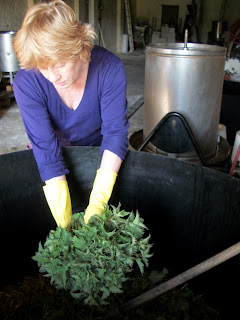Home grown vegetables divide into three kinds, those that taste just the same as the ones you can buy, those that taste distinctly better (the majority), and those that bear no relation to anything you can ever find in a shop. Asparagus is in the third category. Eating white asparagus fresh from the garden for the first time is a totally new experience, and for the cook it is a new vegetable requiring quite different treatment from the bought-in version.
Fresh Asparagus should always be white, blanched by earthing up. If your asparagus is stale, which it starts to become a couple of hours - purists say 20 minutes - after cutting then it doesn't much matter if it's blanched or not, but if it's fresh it is essential. The benefits are two. Firstly, the green tips of asparagus contain mercaptans which don't taste great and which are the things that make your pee smell after eating green asparagus; and blanching eliminates these. Secondly the true flavour of asparagus is not in the green tip but in the white base of the stem which when fresh is not only sweet but has a powerful zingy flavour, or perhaps just an effect on your palate. This zing is what asparagus is all about.
The stems of white asparagus should be peeled with a speed peeler as the scales of the underground shoot are likely to harbour earth and grit. They can be eaten raw but are best if very briefly blanched, plunged into boiling salted water for about a minute. Longer cooking will diminish that all-important zing. Ignore advice about bundling, or standing the asparagus up in a tall pot so the bottoms boil fiercely while the tender tops gently steam. This is irrelevant. If the bases of the stems of your asparagus are tough, they will remain so however hard or long you boil them, and to treat your tips with extra care and respect is to focus on the wrong part of the plant; though it is true that if you insist on a long boil for the base, and the older asparagus is the longer it needs to cook, then the tips of green asparagus will disintegrate.
My favourite way to eat asparagus is in a risotto. You have already formed the view that I am a purist, and how right you are, but to show you I am not a dogmatic one I will share with you a chef's secret that is known by many but admitted to only by a brave few who are prepared to face the derision of the risotto mafia. You do not need to stand over a risotto stirring and fussing for what seems an age to make a perfect risotto. You use a pressure cooker.
Risotto should be al dente. This often misunderstood term means that the rice (or pasta) should be cooked, but retaining a certain firmness and elasticity, giving a resistance to the teeth. It does not mean that it should be undercooked, with a floury white centre. This is unpleasant to eat and hard to digest (would you contemplate eating raw rice?). The problem with the usual method for making risotto, stirring constantly and carefully rationing additions of stock, is that, at least in my experience, by the time the rice is properly cooked in the centre the outside has become mushy, and that toothsome quality we sought has eluded us. We have to choose between undercooked rice and savoury rice pudding. With the pressure cooker method you will get rice properly cooked al dente in a creamy surround every time.
For an asparagus risotto, soften a chopped onion in olive oil in the bottom of the pressure cooker (stainless steel preferably, Lagostina make a good small one that is ideal for risotti), then stir in a measure of rice, roughtly 90g per person but measured by volume, about an espresso cup. Use Carnaroli rice which works best for this method, and use the best you can lay your hands on - Carluccio's is good. Add three times the volume of rice of good home made stock brought to boil in a separate pan, using the same measure you used for the rice, close the pressure cooker, bring to pressure, and simmer for exactly eleven minutes, using a timer. Now peel the asparagus which ideally you picked about ten minutes ago, cut it into bite size pieces, and plunge it into fast boiling salted water for a minute, then drain and briefly refresh with cold water. Grate parmesan and have butter standing by. When your time is up, release the pressure from the cooker and inspect the risotto. If it looks too dry add more stock to get the creamy consistency you want and if any rice is sticking to the bottom - ideally it shouldn't be but this sometimes happens especially if the overall quantity is small - dislodge it with a spatula. Then fold in the asparagus, parmesan, a generous knob of butter and serve with Maldon salt and black pepper. The risotto and stock should not be salted in the cooking stage and should be seasoned only at the table.




